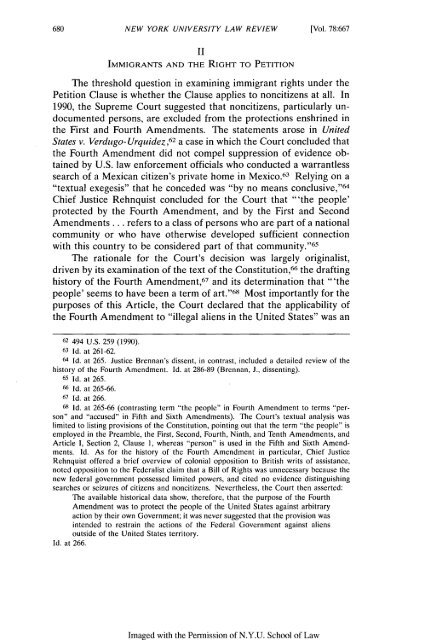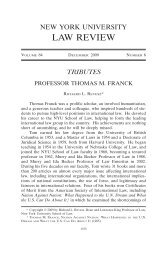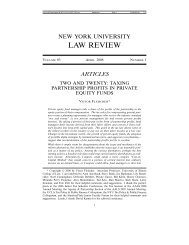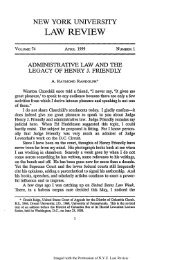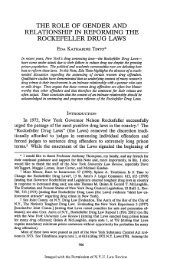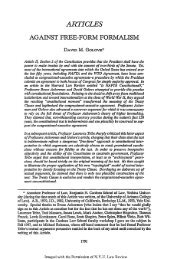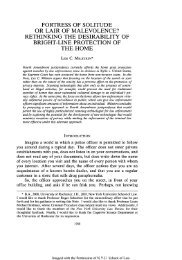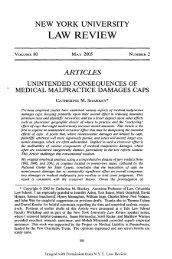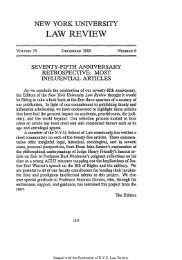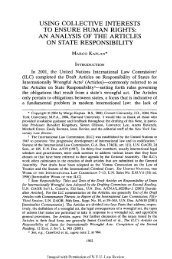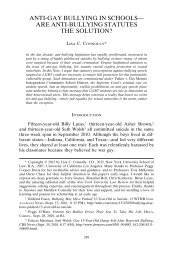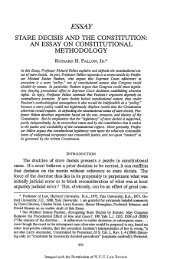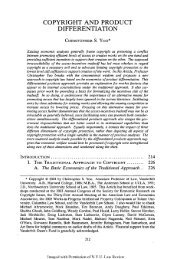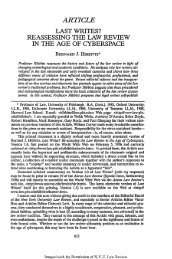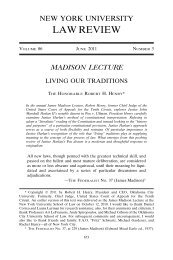Immigrants and the Right to Petition - NYU Law Review
Immigrants and the Right to Petition - NYU Law Review
Immigrants and the Right to Petition - NYU Law Review
Create successful ePaper yourself
Turn your PDF publications into a flip-book with our unique Google optimized e-Paper software.
Imaged with <strong>the</strong> Permission of N.Y.U. School of <strong>Law</strong><br />
NEW YORK UNIVERSITY LAW REVIEW<br />
[Vol. 78:667<br />
II<br />
IMMIGRANTS AND THE RIGHT TO PETITION<br />
The threshold question in examining immigrant rights under <strong>the</strong><br />
<strong>Petition</strong> Clause is whe<strong>the</strong>r <strong>the</strong> Clause applies <strong>to</strong> noncitizens at all. In<br />
1990, <strong>the</strong> Supreme Court suggested that noncitizens, particularly undocumented<br />
persons, are excluded from <strong>the</strong> protections enshrined in<br />
<strong>the</strong> First <strong>and</strong> Fourth Amendments. The statements arose in United<br />
States v. Verdugo-Urquidez, 62 a case in which <strong>the</strong> Court concluded that<br />
<strong>the</strong> Fourth Amendment did not compel suppression of evidence obtained<br />
by U.S. law enforcement officials who conducted a warrantless<br />
search of a Mexican citizen's private home in Mexico. 63 Relying on a<br />
"textual exegesis" that he conceded was "by no means conclusive," 64<br />
Chief Justice Rehnquist concluded for <strong>the</strong> Court that "'<strong>the</strong> people'<br />
protected by <strong>the</strong> Fourth Amendment, <strong>and</strong> by <strong>the</strong> First <strong>and</strong> Second<br />
Amendments... refers <strong>to</strong> a class of persons who are part of a national<br />
community or who have o<strong>the</strong>rwise developed sufficient connection<br />
with this country <strong>to</strong> be considered part of that community. ' "65<br />
The rationale for <strong>the</strong> Court's decision was largely originalist,<br />
driven by its examination of <strong>the</strong> text of <strong>the</strong> Constitution, 66 <strong>the</strong> drafting<br />
his<strong>to</strong>ry of <strong>the</strong> Fourth Amendment, 67 <strong>and</strong> its determination that "'<strong>the</strong><br />
people' seems <strong>to</strong> have been a term of art." '68 Most importantly for <strong>the</strong><br />
purposes of this Article, <strong>the</strong> Court declared that <strong>the</strong> applicability of<br />
<strong>the</strong> Fourth Amendment <strong>to</strong> "illegal aliens in <strong>the</strong> United States" was an<br />
62 494 U.S. 259 (1990).<br />
63 Id. at 261-62.<br />
64 Id. at 265. Justice Brennan's dissent, in contrast, included a detailed review of <strong>the</strong><br />
his<strong>to</strong>ry of <strong>the</strong> Fourth Amendment. Id. at 286-89 (Brennan, J., dissenting).<br />
65 Id. at 265.<br />
66 Id. at 265-66.<br />
67 Id. at 266.<br />
68 Id. at 265-66 (contrasting term "<strong>the</strong> people" in Fourth Amendment <strong>to</strong> terms "person"<br />
<strong>and</strong> "accused" in Fifth <strong>and</strong> Sixth Amendments). The Court's textual analysis was<br />
limited <strong>to</strong> listing provisions of <strong>the</strong> Constitution, pointing out that <strong>the</strong> term "<strong>the</strong> people" is<br />
employed in <strong>the</strong> Preamble, <strong>the</strong> First, Second, Fourth, Ninth, <strong>and</strong> Tenth Amendments, <strong>and</strong><br />
Article I, Section 2, Clause 1, whereas "person" is used in <strong>the</strong> Fifth <strong>and</strong> Sixth Amendments.<br />
Id. As for <strong>the</strong> his<strong>to</strong>ry of <strong>the</strong> Fourth Amendment in particular, Chief Justice<br />
Rehnquist offered a brief overview of colonial opposition <strong>to</strong> British writs of assistance,<br />
noted opposition <strong>to</strong> <strong>the</strong> Federalist claim that a Bill of <strong>Right</strong>s was unnecessary because <strong>the</strong><br />
new federal government possessed limited powers, <strong>and</strong> cited no evidence distinguishing<br />
searches or seizures of citizens <strong>and</strong> noncitizens. Never<strong>the</strong>less, <strong>the</strong> Court <strong>the</strong>n asserted:<br />
The available his<strong>to</strong>rical data show, <strong>the</strong>refore, that <strong>the</strong> purpose of <strong>the</strong> Fourth<br />
Amendment was <strong>to</strong> protect <strong>the</strong> people of <strong>the</strong> United States against arbitrary<br />
action by <strong>the</strong>ir own Government; it was never suggested that <strong>the</strong> provision was<br />
intended <strong>to</strong> restrain <strong>the</strong> actions of <strong>the</strong> Federal Government against aliens<br />
outside of <strong>the</strong> United States terri<strong>to</strong>ry.<br />
Id. at 266.


